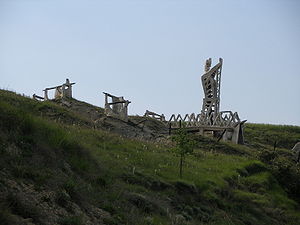Battle of Noain
| Battle of Noain-Esquiroz | |||||||
|---|---|---|---|---|---|---|---|
| Part of the Italian War of 1521-26 | |||||||
 Present day monument on the battlefield. |
|||||||
|
|||||||
| Belligerents | |||||||
|
|
|
||||||
| Commanders and leaders | |||||||
|
Iñigo Fernández de Velasco Antonio Manrique de Lara |
André de Foix | ||||||
| Strength | |||||||
| more than 30,000 | between 8,000 and 10,000 | ||||||
| Casualties and losses | |||||||
| 300 dead | more than 5,000 dead | ||||||
The Battle of Noáin or the Battle of Esquiroz, fought on June 30, 1521 was the only open field battle in the Spanish conquest of Iberian Navarre. It was a decisive victory for the Spanish against the Franco-Navarrese army.
Navarre had been invaded by Ferdinand II of Aragon in 1512, and annexed to Castile in 1515—to become the Kingdom of Spain. After John III's 1516 failed reconquest attempt, his son and legitimate heir apparent to the throne of Navarre, Henry II, saw an option through to reconquer the kingdom now the Castilian army was busy dealing with the Revolt of the Comuneros.
He sent a large French/Navarrese army commanded by General André de Foix, Lord of Lesparre, (or Asparros or Esparre) across the Pyrenees, consisting of 12,000 infantry, 800 mounted knights, and 29 pieces of artillery. With the support of the population, in less than three weeks, all of Navarre was conquered. The only opposition came from Ignatius of Loyola's Castilian garrison of Pamplona. He in turn was severely wounded, trying in vain to defend the city castle. The army then moved into Castile, besieging Logroño.
In the meantime the Revolt of the Comuneros had been crushed at the Battle of Villalar in April, and the Spanish were able to gather a huge army of 25,000 men and moved on Navarre. On June 11, Lesparre abandoned his siege of Logroño and retreated back into Navarre. On June 30, both armies met in front of Pamplona.
The battle was fought in the extended plains between Noáin and Pamplona. The Spanish troops had grown to more the 30.000 men under command of Iñigo Fernández de Velasco, Constable of Castile and the Duke of Nájera, viceroy of Navarre.
...
Wikipedia
